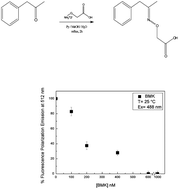Laura Ruvuna, Web Writer
Researchers in Italy have developed a new technique for detecting an amphetamine and methamphetamine precursor, 1-phenyl-2-propanone, also known as benzyl methyl ketone (BMK). Catching the precursors in shipment reduces the manufacturing and availability of these dangerous drugs, but it can be difficult as the density is similar to water. Common techniques such as gas chromatography and HPLC, while effective, require large instrumentation with testing performed in the laboratory. Alternatively, Stefano Di Giovanni, Sabato D’Auria and coworkers synthesized a BMK derivative, with the goal of growing antibodies and detecting the resulting fluorescent signal from binding with BMK. Using this system, they have managed to detect down to 100 nM and, are transitioning from large laboratory equipment towards a smaller, portable optical detection device. This article will be free to read until Oct 19th.
Determination of benzyl methyl ketone – a commonly used precursor in amphetamine manufacture
Stefano Di Giovanni, Antonio Varriale, Vincenzo Manuel Marzullo, Giuseppe Ruggiero, Maria Staiano, Alberto Secchi, Luigi Pierno, Anna Maria Fiorello and Sabato D’Auria
Anal. Methods, 2012, Advance Article
DOI: 10.1039/C2AY25772F











